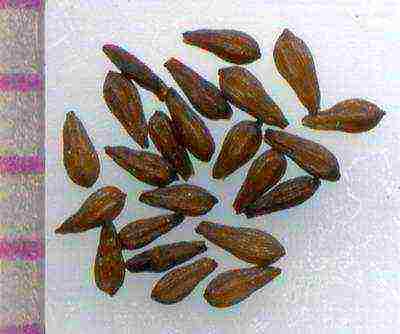Content
- 1 Methods and timing of reproduction of chrysanthemums
- 2 Chrysanthemums, planting in spring and autumn
- 3 Chrysanthemums, care - watering, feeding, pruning, shelter
- 4 How to create globular chrysanthemum bushes
- 5 Types by flower size
- 6 Growing methods
- 7 Cultivation in the ground and care
- 8 Diseases and pests
- 9 Wintering
- 10 Outcome
- 11 The choice of planting material in the fall
- 12 Preparing a place for planting chrysanthemums
- 13 How to prepare a planting pit for a chrysanthemum in the fall
- 14 Chrysanthemum bush division
- 15 Chrysanthemums leaving in autumn
- 16 Watering chrysanthemums in autumn
- 17 Feeding chrysanthemums in autumn
- 18 Reproduction of chrysanthemums by cuttings in autumn
- 19 Pruning chrysanthemums in the fall
- 20 Nice place for flowers
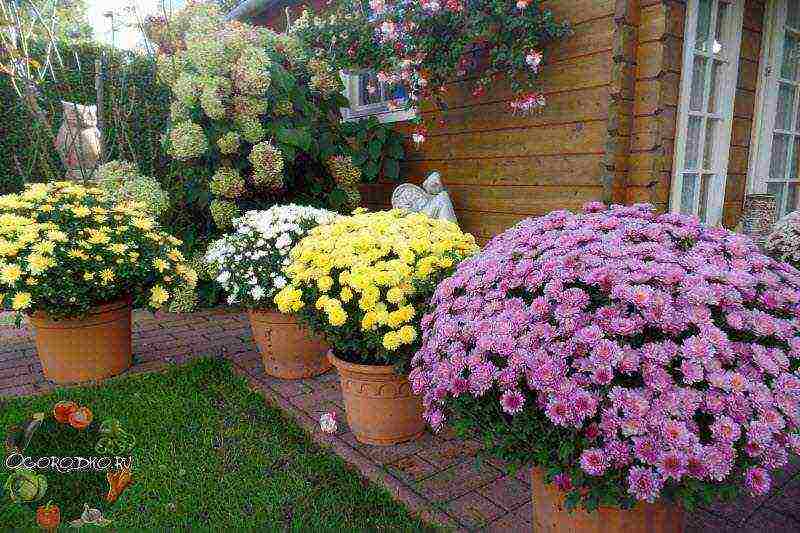
The main autumn flowers are chrysanthemums, planting and caring for these flowers in the open field is not particularly difficult, but they require compliance with a number of conditions when growing, both in spring and autumn. Do not break the rules if you want to plant a flower from a bouquet or root a shoot, but to propagate a plant in the fall, check out the main points. If you do not know how to form a beautiful bush with a ball, then remember, you need a pinch and pruning for the winter, or try to grow a special variety that will only need a single pinching ...
Methods and timing of reproduction of chrysanthemums
Chrysanthemums are annual - they are grown annually from seeds, and perennial - they can be propagated by seeds, cuttings, mother plants or by dividing a bush. Chrysanthemums are planted in spring and autumn, each season has its own advantages:

- Seeds sown in open ground in May, and when the seedlings grow by 10 cm, they are pinched. In the fall, chrysanthemums are already blooming
- Cuttings Is a very popular breeding method for chrysanthemums. You can grow a bush by cutting off a stalk even from a bouquet. How to root a chrysanthemum shoot? A shoot about 6 cm long is rooted in a soil consisting of sand and peat. The box covered with glass is kept in a cool place, not higher than + 15 ° C. When the roots appear, the plants are planted in separate pots and then, with the end of the frost, in the open ground. If you purchased a cuttings of the desired variety in the fall, do not plant it in the ground, but root it in a container and leave it in a cool room until spring
- Uterus - this is the overwintered rhizome of chrysanthemum, from which shoots will go, it can be purchased and planted in early spring
- Dividing the bush - the only way to plant chrysanthemums in autumn, in which the plant is carefully dug up, the roots of the mother bush with shoots are divided into several copies with pruning shears and planted. This procedure is supposed to be carried out every two years to rejuvenate the plant.
Chrysanthemums, planting in spring and autumn
Please note that if you decide to grow chrysanthemums, planting and care in the open field differ in spring and autumn - with spring planting, mother plants and cuttings take root better, but in autumn you can choose a flowering bush and not be mistaken with its appearance.
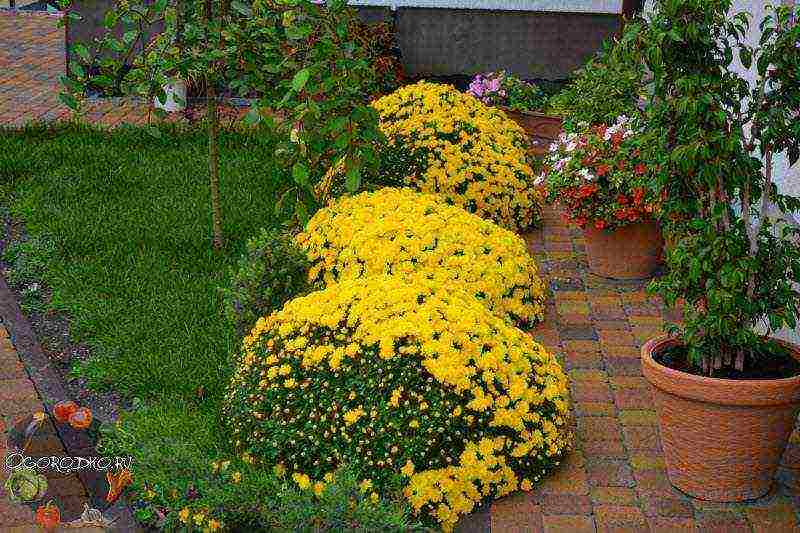
In very frosty winters, choose Korean small-flowered hybrids of chrysanthemums, which are nicknamed the oak - this species unites many varieties zoned in the middle lane and the Moscow region. Large-flowered Indian chrysanthemums are tall - they grow up to a meter, and sometimes up to one and a half, but they are afraid of cold weather and easily freeze out.
For chrysanthemums, choose a sunny, preferably elevated place.Flowers do not like stagnant moisture, therefore, the waterlogged soil is drained by adding a layer of coarse river sand to the planting hole. The soil is preferable slightly acidic or neutral, light and loose. Too dense - mixed with peat, humus or rotted compost.
Chrysanthemum plants are placed every 30-50 cm.The pit is dug shallow so that the shoots on the mother liquor or two-thirds of the cuttings are not covered with earth, when dividing the bush - this is about 40 cm.No more than 0.5 kg of humus or compost is added to the hole. If you overdo it with fertilizers, the flowers will be small, and only foliage will be lush. It is recommended to water the roots with a stimulant (Epin, Kornevin, Heteroauxin), and then cover it with soil and compact it. After spring planting, it is advisable to cover the cuttings from the sun with a spunbond for a couple of weeks.
When planting in autumn, the chrysanthemum bush must be watered abundantly, this will compact the soil, eliminating voids in it, because of which the roots can freeze. In addition, the flowers are cut and a third of the stems are left for the nutrients to go into the development of the root system.
Chrysanthemums, care - watering, feeding, pruning, shelter
Chrysanthemum cannot stand moisture stagnation, but loves watering - without water, the stems become tough, the flowers become smaller. At the same time, the flower does not tolerate sprinkling, it must be watered at the root, preferably with rain or settled water. After watering, the soil is loosened to avoid crusting.

In spring, for chrysanthemums, nitrogen fertilization is necessary for rapid growth; it can be carried out 2-3 weeks after planting. In the second half of summer, with the beginning of budding of chrysanthemums, phosphorus-potassium fertilizers are applied to ensure lush flowering and strengthening of plants before wintering. In the fall, you can feed the flowers a little with organic matter. Tall varieties are tied up, as their fragile stems can break.
The onset of frost is a signal that it is time to leave for the winter. The trunks of chrysanthemums are cut in late autumn, leaving 10-centimeter stumps and insulated with sawdust or foliage. The most delicate varieties are wrapped on top with a covering material and something flat is placed on top to protect it from moisture - for example, a plywood board. Some growers dig up the roots and store them in a dark, cold cellar in winter to make sure the variety is preserved.
How to create globular chrysanthemum bushes
For flowers such as chrysanthemums, planting and care in the open field is not all that is needed and simple processing will allow you to create real masterpieces from them.
Chrysanthemums after winter are pruned and pinched to get a beautiful spherical bush. There is a variety in which the bush itself grows in the form of a ball, without needing to be formed - this is chrysanthemum multiflora, a low-growing bush up to 20 cm in height - when two pairs of leaves appear on the shoot, it is pinched, and then the ball forms itself.
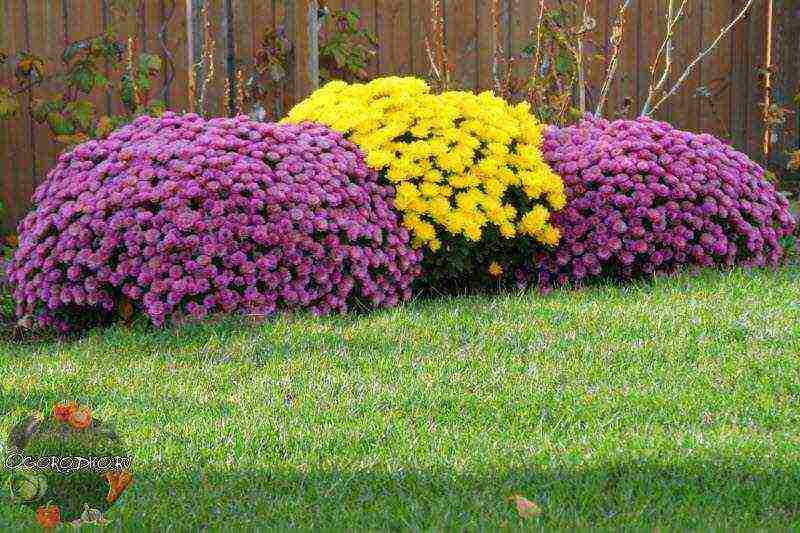
Multiflora can be grown not only in a flower bed, but also in a pot. But, at the end of flowering, the aerial part of the plant is cut off and sent to rest - in a dark, cool place, for the whole winter. Periodically dormant chrysanthemums are watered so that the roots do not dry out. In February, the first shoots appear, which means that the plant has woken up, and it is time to get it out of the basement. If a spherical chrysanthemum grows in a flower bed, the stems should be cut to 10 cm and covered with sawdust and non-woven fabric for the winter.
Multiflora loves soil rich in fertilizers, add more humus and wood ash to the hole when planting. If you grow it in a pot, you can prepare the soil from 30% humus and 20% sand, the remaining 50% is sod land.
You can also form a ball from other types of chrysanthemums, in small and medium-flowered ones, the main shoot is pinched when it reaches 10-12 cm, then the lateral shoots that have grown to the same length are cut off, they then actively branch, the pinch is done until the buds appear.
In large-flowered species of chrysanthemums, stems 15 cm long are cut, in total one or two pinches are carried out no later than June, in addition, they are stepchildren - from mid-July, shoots that appear from the leaf axils are removed daily, and starting from August - every three days, then you can get a spherical bush with large flowers up to 10 cm in diameter.
Chrysanthemum is a representative of the Asteraceae family (Asteraceae), it combines herbaceous forms and dwarf shrubs, perennials and annuals. It was brought to us from Japan, where it is considered the state flower and is depicted on coins and the state emblem. Among the variety of forms there are indoor, garden and varietal, designed for cutting and creating bouquets. The flower is unpretentious, it is very popular both among gardeners and among buyers - chrysanthemum ranks second in the number of plants grown for making flower arrangements, after a rose.
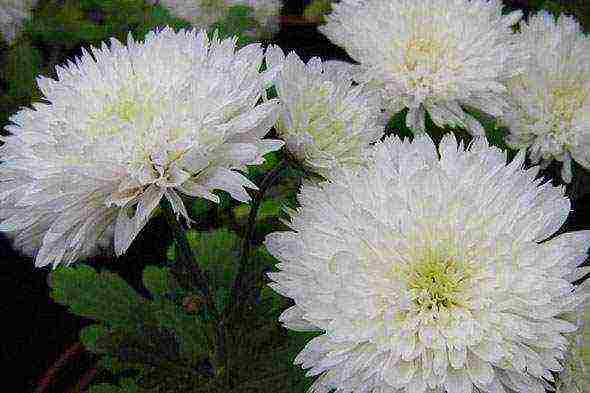
Types by flower size
Blooms from late summer to late autumn. Depending on the size of the flower, there are:
- Large-flowered chrysanthemum (height up to 130 cm, diameter up to 25 cm) is a luxurious look with large flowers, most often used for cutting. It does not tolerate winters in the open field, but recently varieties capable of this have been bred. Common varieties are Anastasia Green, Zembla Lilak, Tom Pierce.
- Mid-flowered chrysanthemum (height up to 75 cm, diameter up to 15 cm) - flowers are more often collected in inflorescences than single ones. Used for decorative purposes in gardens, parks, planted in open ground, flowerpots, bowls. It can be used for landscaping terraces, balconies or for cutting. Popular varieties: Golden Fleece, Pink Chamomile, Champagne Splash.
- Small-flowered or perennial Korean chrysanthemum (height up to 1 m, diameter up to 8 cm) - bush form, has dark green foliage, popularly called "oak", because resembles oak leaves in shape. Flowers are arranged frequently, up to 100 pcs. on one plant, of the most varied colors. It blooms from September until late frost. Unpretentious, tolerates frost well, reproduces by dividing the bush. The best varieties for the garden are Multiflora, Etna, Slavyanochka.
Growing methods
In the conditions of the Moscow region, chrysanthemum can be grown in three ways:
- from seeds,
- dividing the bush,
- by cuttings.
By dividing the bush, perennial species breed. In the spring, when the threat of frost has passed, we dig up the main bush, carefully separate the young shoots and immediately plant them in a previously prepared trench, water abundantly.
Chrysanthemum can also be grown by cuttings. In the spring, it is necessary to cut off the green shoots coming directly from the root (the lateral ones will not work), treat the lower part with "Kornevin" and plant in the ground. It is recommended to protect the stalk from the sun with a covering material. You can take a newspaper, or any non-woven material.
Seedlings from seeds. This method is used when planting annual varieties, as well as if you want to achieve early flowering or breed a new perennial. Planting is done in shallow boxes with pebble drainage at the bottom. You can choose the soil ready-made in the store, or prepare it yourself: mix peat, humus and greenhouse soil in equal parts. Spread the prepared substrate over the drainage in an even layer, place the seeds, press the perennial varieties with a finger, without the top layer, and sprinkle annuals with a thin layer of soil (0.4-0.6 cm). We spray, cover with glass or film, the optimum temperature for germination is 23-25 ° C. Seedlings are expected in 1.5-2 weeks. In the phase of two true leaves, we make a pick of the seedlings.
Cultivation in the ground and care
Chrysanthemum is a short day plant, i.e. the formation of flowers directly depends on the duration of the light period, thanks to this it is easy to forcing (flowering at an unusual time for it).To form a beautiful spherical bush, it is necessary to pinch the central and lateral shoots.
When choosing a place for planting, pay attention to the fact that the flower loves bright, diffused light, but it must be closed from the midday sun.

Watering is moderate, as needed, with soft, settled water, at the root. Spraying can be done infrequently, but more for hygienic purposes and not for moisturizing.
Chrysanthemum is very friendly in relation to the neighborhood with other plants, goes well with marigolds, asters, zinnia, cosmea and balsam.
Planting in open ground is more often carried out in the spring, when the possibility of night frosts has passed, but it is also possible in the fall. A shallow trench is being excavated, because the rhizome grows in a horizontal plane, a spill is made, the plants are laid out at a distance of 20-50 cm from each other, depending on the variety, and, in fact, the planting is carried out. After that, it is advisable to pour them with Kornevin's solution in water for better and faster development of the root system. To create a lush bush, the plant must be pinched. If the day is sunny, protect the newly planted flowers from the sun.
The flower needs constant feeding, the intensity and frequency of flowering depends on it. During the growing season, they feed at least 3 times - alternately organic and mineral fertilizers. Of the latter, it is better to first choose nitrogenous ones - to form a powerful green mass, and during the budding period - phosphorus-potassium ones, to stimulate intense flowering. Organic - mullein and bird droppings can be applied between minerals, the main thing is not to burn the plant. You can use complex fertilizers.
Chrysanthemums need soil mulching - pine bark, sawdust, needles are suitable as mulch. This process slows down the formation of weeds around the plant, protects against parasites.
Diseases and pests
Chrysanthemum attracts with its beauty not only people, but also insects, some of which have a destructive effect on it. For example, aphids and meadow bugs, both adults and larvae, suck sap from the plant, after which it turns yellow, loses leaves, and lags behind in development. Another uninvited guests are nematodes, it is useless to fight them, but it is possible to carry out prophylaxis before planting - treat the plants with a solution of phosphamide, and the ground with formalin.
Sick plants are removed and burned in the fall.
When snails and slugs appear, they must be removed.
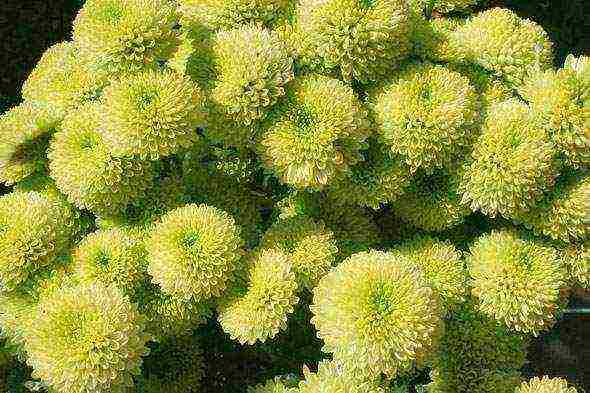
Chrysanthemums are characterized by viral diseases - dwarfism, mosaics, which cannot be cured, they must be detected in a timely manner and the affected specimens must be removed. Fungal diseases - gray rot, rust, powdery mildew - are treated with preparations containing copper.
Wintering
As already mentioned, large-flowered specimens cannot survive the winter outdoors, therefore, when cold weather sets in, the bush is cut off (the ground part is 10-15 cm) and the rhizome is sent to a cool place (0-5 ° C) for wintering. With the onset of heat, disembarkation is made.
The small-flowered form tolerates winter well without shelter, with the exception of young individuals.
It's not so difficult to create a bright autumn - plant several chrysanthemum bushes on your site and they will delight your eye with juicy, bright, varied flowers, dream up - create a shape you like, experiment - make a flower forcing by March 8, this will be a wonderful gift!
Perennial garden chrysanthemum - planting and care, photo in pots
The rich heads of the bushes of blue, burgundy, yellow, purple color adorn the gardens until the first snow, when other plants have long withered. Therefore, among gardeners, another name for chrysanthemum is known - the queen of the autumn garden. This is what chrysanthemums are called.
Types and common varieties of chrysanthemums
Perennial chrysanthemums are divided into two large groups according to the size of the inflorescences.Each of them includes many different varieties.
Chrysanthemum Korean Froggy
Small-flowered
These include the Korean chrysanthemum, the planting and care of which are discussed in our material. The size of the flowers varies from 2 to 10 cm, the shape of the leaves resembles that of oak, but much smaller. Flowering begins in early autumn and may continue until frost. Popular varieties of chrysanthemums in the Moscow region: Cheburashka, Talisman, Multiflora.
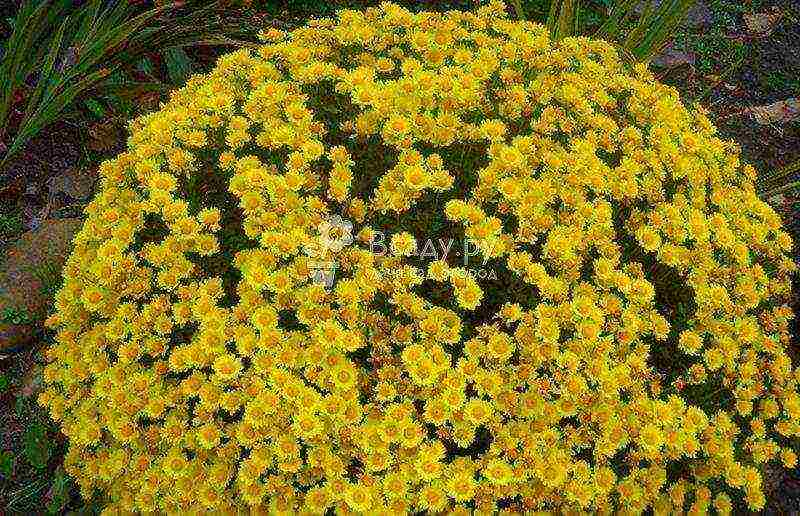 Chrysanthemum Korean Multiflora
Chrysanthemum Korean Multiflora
Large-flowered
Tall plants with large single (10-25 cm) flowers, intended for cutting. They do not tolerate a sharp drop in temperature, they often freeze and die in the open field, therefore in the Moscow region they are almost never used as garden ones. Common varieties in the southern regions of Russia: Orange ball, Valentina Tereshkova.
Chrysanthemum large-flowered Valentina Tereshkova Perennial chrysanthemums - planting and care in the open field
It is recommended to transplant pre-purchased or home-grown seedlings into open ground in late May - early June. Chrysanthemums are very fond of the sun, so even a light partial shade is not suitable for them - the plant will bloom poorly and may die.
The composition of the soil should be rich in organic matter and breathable, therefore, when preparing a flower bed for chrysanthemums, it should be dug deeply - by 50-60 cm.Pre-add manure and humus at the rate of 0.5 buckets per 1 sq. m. In this case, it should be remembered that too much organic matter provokes foliage growth, while flowering is scarce and scarce.
Chrysanthemum loves open sunny surfaces
It is important to choose the right watering regime for the plants. Varieties with small and hard foxes require less water than chrysanthemums with large, soft-touch leaves, which have a much larger area of moisture evaporation. Overfilling, as well as underfilling, can cause the buds to drop.
Pruning and pinching chrysanthemums
Pinching and pruning are mandatory procedures for caring for chrysanthemums of all types. When the main shoot reaches 10-12 cm, its top is pinched off for the first time. After the side shoots reach the same height, they should also be pinched. This will help to form a beautiful plant head and prolong its growth.
During the flowering period, wilted buds should be removed in order to provoke the blooming of new flowers. When growing some large-flowered chrysanthemums, gardeners cut off all lateral shoots to obtain a strong and large flower stalk.
Top dressing of perennial chrysanthemums
The first feeding of chrysanthemums can be done within 10-15 days after planting, during the growth of roots and shoots. For this, the usual infusion of mullein is suitable at the rate of 0.5 liters per plant. A similar feeding should be carried out during the period of bud ovary. During the flowering period, the plant will respond well to complex fertilizers, for example, Kemira Lux.
Perennial chrysanthemums care and cultivation video
Dangerous diseases and pests of chrysanthemums
Chrysanthemums, the cultivation and care of which can be called easy, are resistant to diseases and parasitic insects. It is necessary to inspect them in a timely manner when watering or pruning in order to identify the appearance of parasites and the spread of fungi.
Spider mite
Its appearance is easy to notice by detecting the primary sign of the tick's vital activity - the cobweb on the back of the leaf. The edges of the leaves gradually become brown and dry. Abundant spraying under pressure and the use of a soap solution (20 grams of copper sulfate, 200 grams of green soap diluted in 10 liters of water) helps to get rid of the pest.
Spider mite on perennial chrysanthemum
Leaf nematodes
Their appearance is accompanied by a change and darkening of the lower leaves, then the disease spreads up the entire plant.Control methods: remove damaged parts of the plant, use a spray containing insecticidal oil.
 Signs of a leaf nematode
Signs of a leaf nematode
Powdery mildew
White fungal bloom appears on the leaves and buds, resembling lime paint. To fight, you can use Bordeaux liquid or copper oxychloride.
Reproduction of chrysanthemums
Reproduction of chrysanthemums occurs in two ways: seed and vegetative.
Seed propagation
Seeds are planted in open ground in early May, placing 3 seeds in each hole. The distance between seedlings should be at least 20 cm for small-flowered varieties and 50 cm for large species of chrysanthemums.
Watering is carried out as the soil dries up, and the first pinching is done when the sprout reaches a height of 10 cm. By the end of summer, the seedlings of the current year will bloom.
 Seedlings of perennial chrysanthemum seeds
Seedlings of perennial chrysanthemum seeds
Propagation by cuttings
The most popular method for propagating chrysanthemums, as the cuttings take root quickly and well.
 Reproduction of perennial chrysanthemum green cuttings
Reproduction of perennial chrysanthemum green cuttings
A shoot 6-7 cm long is cut from an adult plant and rooted in a mixture of peat and sand. After spraying, the container is covered with glass and placed in a cool room, the temperature is maintained at plus 12-15 degrees Celsius. After the roots appear, the cuttings are transplanted into separate pots, and they are transferred to the open ground after the threat of night frosts has passed.
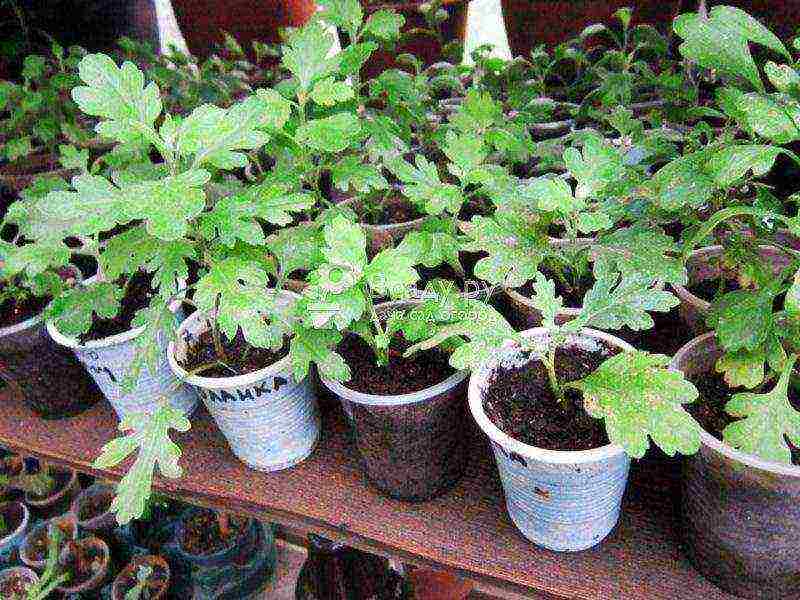 Rooted cuttings of chrysanthemums prepared for transplanting Preparing chrysanthemums for winter
Rooted cuttings of chrysanthemums prepared for transplanting Preparing chrysanthemums for winter
For the abundant flowering of chrysanthemums, planting and care are as important as further preparation for winter. In order for the culture to please you in the next season, you should take measures to hide it. First of all, the flower should be cut at the very level of the ground, then carefully spud and covered with fallen leaves.
Large-flowered varieties of chrysanthemums do not winter outdoors. They are dug up together with an earthen lump, placed in a pots or box and stored until spring in a room at a temperature of 0 to plus 5 degrees Celsius. Occasionally, an earthen ball should be moistened by spraying or watering.
Digging the rhizomes of large-flowered chrysanthemums for the winter
Outcome
Diverse bushes of chrysanthemums of various colors are in perfect harmony with each other, giving the gardener the right to combine them at his own discretion. Even a small flower bed decorated with these plants will make your site luxurious and you can show off to your guests.
The main autumn flowers are chrysanthemums, planting and caring for these flowers in the open field is not particularly difficult, but they require compliance with a number of conditions when growing, both in spring and in autumn. Do not break the rules if you want to plant a flower from a bouquet or root a shoot, but to propagate a plant in the fall, check out the main points. If you do not know how to form a beautiful bush with a ball, then remember, you need a pinch and pruning for the winter, or try to grow a special variety that will only need a single pinching ...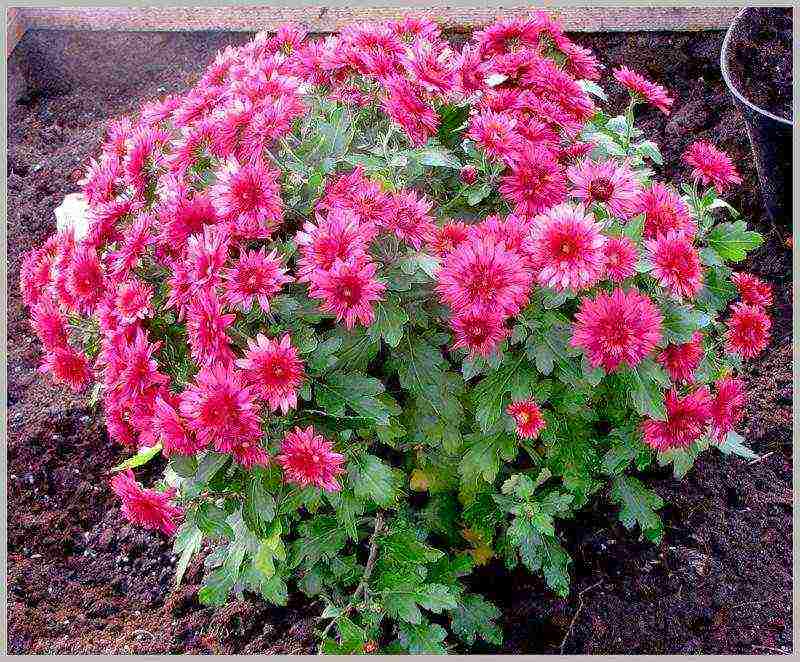
The choice of planting material in the fall
Autumn planting material is the most convenient in the selection of varieties. At this time, flowering bushes are usually sold in pots or with a closed root system in a film. But here it is necessary to carefully study not the bush itself, but its roots. More precisely - look if there is young growth in the pot or near the central trunk, which speaks of the viability of the chrysanthemum. If not a single sprout breaks out of the peat, it is better not to buy such a plant, since the probability of successful wintering in the ground is almost zero. But there is a chance to keep the bush in the basement.
Fresh articles about garden and vegetable garden
Preparing a place for planting chrysanthemums
Chrysanthemums prefer sunny areas. It is better to break the bed on a hill. In the shade, the plant looks depressed. The flower is sensitive to groundwater. If they are close to the roots, good drainage will be required.River sand can be used as a drainage layer.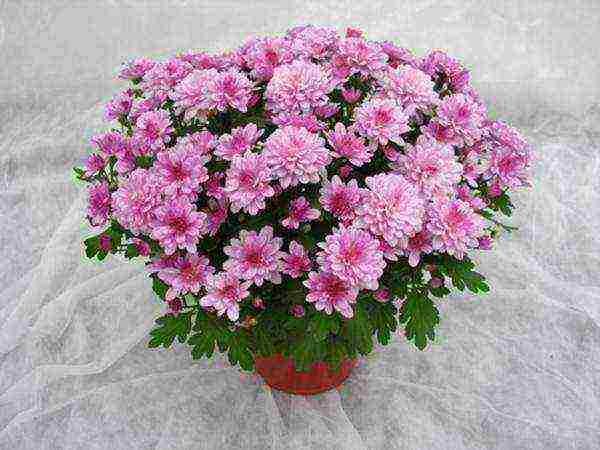
The soil on the site should be loose, preferably neutral or slightly acidic. If the soil for planting is too heavy, then it is enriched with peat, humus and rotted manure. No more than 0.5 kg of fertilizer is added to each hole, otherwise the plant will have a good crown next year, but flowering will be poor.
How to prepare a planting pit for a chrysanthemum in the fall
The depth of the planting hole for chrysanthemum does not exceed 40 cm. Each hole is well drained, fertilized and watered. The bush is lowered into a hole, practically without deepening it. After planting tall varieties, a support is installed. Seedlings need to be pinched, which is carried out immediately after planting. In hot autumn, the plant is shaded for a week from sunlight. Chrysanthemum rooting is slow. If there are difficulties with the autumn planting of chrysanthemums in the ground, then you can plant a seedling in a container. Choose a shallow but spacious drawer. The root system of the plant lies closer to the soil surface and does not require significant deepening. Shrub shoots are cut 2/3 of the height. Pots with seedlings are stored in the basement, where the temperature does not exceed +6 degrees. During the entire storage period, it will be necessary to occasionally water the plant, preventing the dryness of the earthen coma.
Chrysanthemum bush division
Chrysanthemums reproduce very well by dividing the bush. Moreover, the bush must be divided every 2-3 years, otherwise the flowers of a thickened bush become smaller, diseases develop more often. And one day in spring you will find that the mother bush has disappeared, and this can happen even in a not very harsh winter. On the periphery of the bush, one or several undergrowth sprouts can survive, and its center turns out to be bare. And there is only one reason for the death of the bush - there was no regular spring planting of numerous chrysanthemum shoots.
Therefore, in the spring, when the return frosts end, you need to carefully dig out the bush and free it a little from the ground.
Then, with a sharp pruner, divide the young growth, immediately plant the shoots with roots in the garden with an interval of 35x35 cm or 40x 40 cm and water. You can put it on the same place, you can put it on another, but you need to plant it a little deeper.
The soil around the plants must be well compacted, otherwise there will be strong shoot growth and weak flowering. In the first days after planting the shoots, they must be watered abundantly.
By the beginning of autumn flowering, a lush, magnificently flowering bush is formed from each such shoot.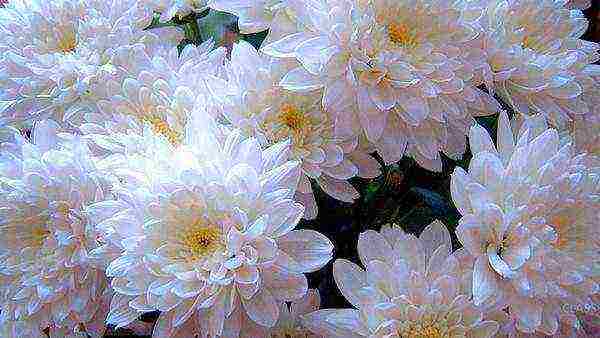
Chrysanthemums leaving in autumn
Care for fading chrysanthemums is as follows. With the arrival of the first frost, they are cut at a level of 12-15 cm from the ground. Then they spud and lay a layer of mulch with a thickness of about 35 cm.It is better to choose dry foliage as a material. If severe frosts are expected in winter, then it would be wise to make additional shelter from spruce branches.
Many thermophilic varieties will not be able to winter outdoors, so they are dug up in the fall. Such bushes, along with a lump of earth, are placed in wooden boxes or separate containers and stored in a cool place. Sunlight must be in the room, the air temperature is required + 3–6 ° C. Periodically, a clod of earth needs to be moistened. Landing in open ground can be done in May, when the weather becomes consistently warm.
Watering chrysanthemums in autumn
For irrigation, only settled in a barrel is used, preferably rainwater. Chrysanthemums love moisture, so watering should be plentiful. It is better to use a garden watering can without a sieve, since water droplets on the foliage will negatively affect the decorative effect of the bush. If the soil is not mulched, then once a week it is recommended to weed the weeds and gently loosen the topsoil.
Fresh articles about garden and vegetable garden
Top dressing of chrysanthemums in the fall
Top dressing is necessary for plants throughout the season.In summer - 6 weeks after planting and caring for chrysanthemums, in autumn - during budding. The first top dressing is carried out with complex fertilizers with a predominance of nitrogen, so that the flower quickly gains a green mass, then potassium-phosphorus compositions are added. Chrysanthemum roots are sensitive, so solutions should be applied after watering or rain.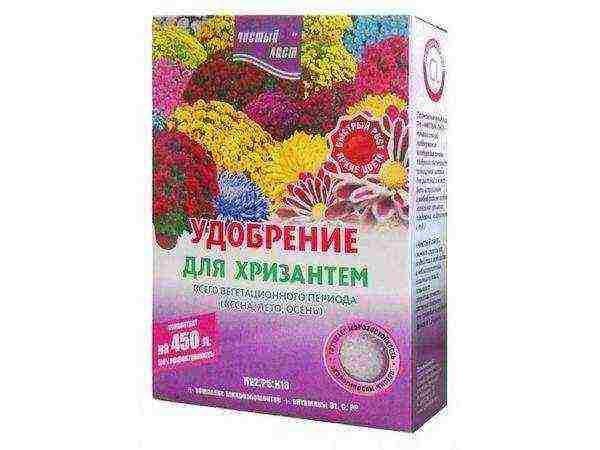
Reproduction of chrysanthemums by cuttings in autumn
It is recommended to propagate chrysanthemums by cuttings (cuttings) from late February to early June. Cutting is the most reliable and productive way of chrysanthemum propagation.
Cuttings - Plants for propagation in the fall are cut low and dug up and stored in a dark and cool room. The temperature in this room should be within 6-8 degrees Celsius. The dug out plants are covered with sand. In this state, the plants are stored until the end of February, periodically watered.
At the end of February, the bushes are transferred to a room with an average temperature of 15 degrees Celsius and planted in pots with fertile soil. The recommended composition of the soil is as follows: humus, leaf or garden soil and sand, in a ratio of 2: 3: 1.
The planted plants are watered and, after 1 week, fed with a solution of ammonium nitrate, using 20 grams of nitrate per 10 liters of water. In the room where the chrysanthemums are planted, it is recommended to install the backlight so that the light falls on the plants not from the side, but from above. Thanks to the stimulation, the chrysanthemums will begin to grow vigorously. Then proceed directly to grafting.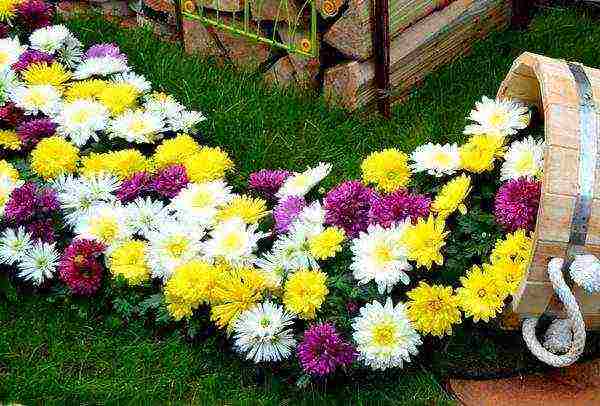
Pruning chrysanthemums in the fall
Not all growers believe that chrysanthemums need to be cut before wintering. Many people think this is superfluous, but some still practice. The point of pruning is that shortened stems require fewer resources for their life. It turns out that, thus, the roots of the plant, as it were, retain their strength, therefore they successfully winter. But this is not always the case. Pruning is not a guarantee that chrysanthemums will survive until spring.
Another advantage of pruning is that shortened branches are easier to cover for the winter. They do not need to be bent down and somehow arranged.
Nice place for flowers
Planting a chrysanthemum in the fall is important in a place where it could take root in the shortest possible time. In the case of this flower, this is a dry, sunny place. Chrysanthemums do not tolerate shade and a lot of moisture, so it is better to plant them on some elevation. As a rule, in such places there is no thick shade, and a small breeze blows through the ground, which removes excess moisture.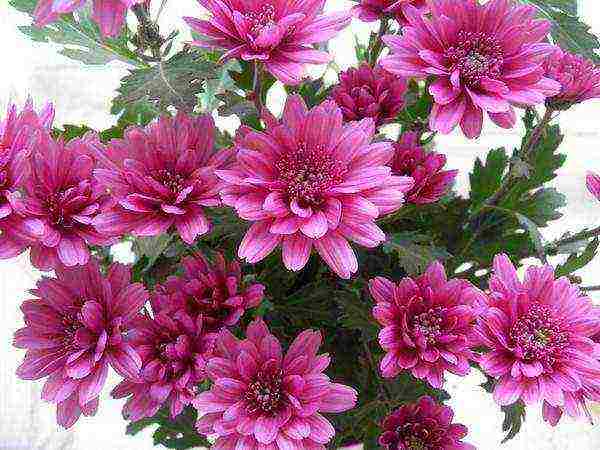
We plant chrysanthemums in the fall in loose soil that allows moisture and air to pass through well. This will provide the plant with rapid growth and abundant flowering. Do not forget about the nutritional value of the soil. The more organic matter and minerals it contains, the better. If the soil in your garden is not at all like that, then you can improve its qualities yourself. To do this, season the soil with rotted manure, add peat or compost to it. You can also mix the soil in which you will plant the flower with sand. This will improve its drainage properties.

